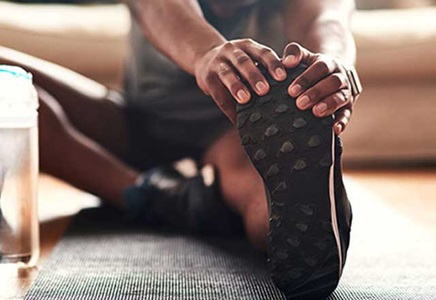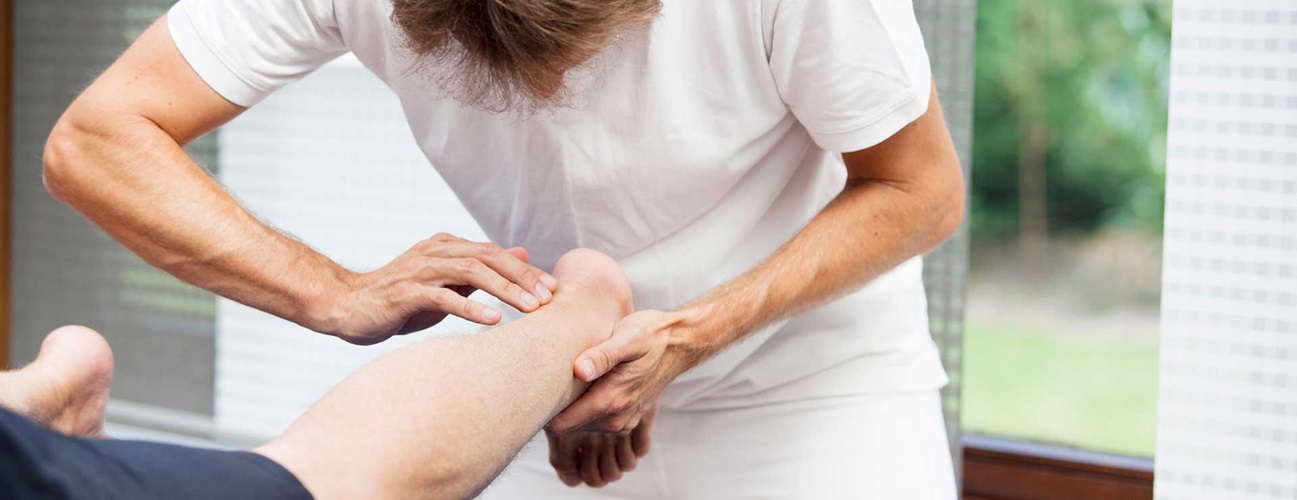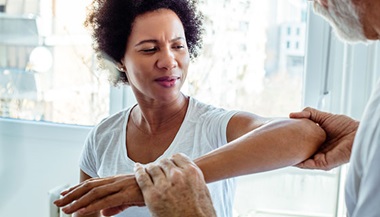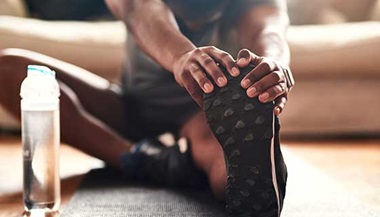Achilles Tendon Injuries
What are Achilles tendon injuries?
The Achilles tendon is a fibrous band of tissue that links the muscles in your calf to your heel. The strength and flexibility of this tendon are important for jumping, running, and walking. Your Achilles tendon bears a lot of stress and pressure during everyday activities, as well as during athletic and recreational play. If it becomes inflamed, swollen, and irritated, it's called tendonitis.
What causes Achilles tendon injuries?
Achilles tendon injuries can be caused by the following:
Tendonitis
Tendonitis might be due to overuse or damage to the area. It can cause pain down the back of your leg and around your heel. You might notice that parts of your tendon are getting thicker and hardening because of tendonitis. This will get worse if you don't treat it. There are two main types of tendonitis:
-
Noninsertional Achilles tendonitis. Small tears in the middle fibers of your tendon start to break it down. This causes pain and swelling. This type of tendonitis usually affects active, younger adults.
-
Insertional Achilles tendonitis. This damage occurs in the spot where your tendon meets your heel bone. Bone spurs (extra bone growth) often form with this type. This type of tendonitis can happen at any age, even in people who aren't active.
Rupture
The tears in your tendon fibers can cause a complete or partial break (or tear) in your tendon. You might hear a pop that seems to come from the back of your heel or calf. This may be a tendon rupture, which needs immediate medical attention.
Achilles Tendinosis: Q&A with Dr. Nigel Hsu
Dr. Nigel Hsu answers common questions about diagnosis and treatment of Achilles tendinosis.
Key points about Achilles tendon injuries
-
Your Achilles tendon can develop tendonitis. This is when it becomes inflamed, swollen, and irritated.
-
The Achilles tendon can also tear or rupture, which might sound like a pop that seems to come from the back of your heel or calf. This needs immediate medical attention.
-
Anyone can develop an Achilles tendon injury and it’s often linked to repetitive stress on the tendon.
-
Achilles tendon injuries often cause pain, stiffness, and swelling in the back of your leg near your heel.
-
Achilles tendon injuries can be treated with rest and medicines to help with the inflammation. Exercises often help too. If needed, surgery can be done to repair the tendon.
-
You can help prevent these injuries by doing things like increasing activity slowly, wearing the correct shoes for your activities, and not exercising on uneven surfaces.
Seminar Common Sports and Activity Related Injuries: What to Consider from Pain to Breaks

Who is at risk for Achilles tendon injuries?
Anyone can develop an Achilles tendon injury. They’re often linked to repetitive stress. The most common risk factors are:
-
Increased amount or intensity of an activity or sport
-
Starting a new sport
-
Tight calf muscles when starting an exercise or sport, which can place more stress on your tendon
-
Bone spurs on your heel, which can rub against the tendon
-
Wearing the wrong shoes when you exercise
-
Exercising on an uneven surface
-
Treatment with the antibiotic fluoroquinolone
What are the symptoms of an Achilles tendon injury?
Common symptoms of tendon injuries include:
-
Pain down the back of your leg or near your heel
-
Pain that gets worse when you're active
-
A stiff, sore Achilles tendon when you first get up
-
Pain in the tendon the day after exercising
-
Swelling with pain that gets worse as you're active during the day
-
Thickening of your tendon
-
Bone spurs on the heel bone
-
Difficulty flexing the affected foot
-
A pop sound and sudden sharp pain, which can mean a ruptured tendon
How is an Achilles tendon injury diagnosed?
Injury to the Achilles tendon causes pain along the back of your leg near the heel. Sometimes healthcare providers misdiagnose Achilles tendon injuries as sprained ankles. It’s important to get the right diagnosis so you can get the right treatment. Several common injuries can make your Achilles tendon painful or prevent it from working well.
Your healthcare provider will consider the following when making a diagnosis:
-
Your overall health and medical history
-
A description of your symptoms
-
A physical exam of your Achilles tendon to check for bone spurs, pain, and swelling
-
A test to see if you can move your ankle correctly (range of motion)
-
Imaging tests, such as ultrasound, X-ray, or MRI. An X-ray shows bones and can show bone spurs and if the tendon has become calcified or hardened. Your provider will usually use MRI to see how severe the tendon damage is and what treatment is best for you.
How are Achilles tendon injuries treated?
Treatment depends on how badly injured your tendon is. It may include:
-
Rest
-
Ice
-
Nonsteroidal anti-inflammatory drugs for pain relief, such as ibuprofen or naproxen
-
Specific exercises to strengthen your calf muscles
-
Physical therapy
-
Eccentric strength training. This type of exercise helps strengthen your calf muscles to take pressure off your tendon
-
Low-impact activities, such as swimming
-
Heel lifts in shoes, orthotic shoes, cast, splint, or a walking boot
-
Extracorporeal shockwave therapy. This treatment uses high-energy shockwave impulses to help stimulate the healing process in damaged tendon tissue. This treatment isn’t often used. However, your healthcare provider may recommend it to see whether you can improve without surgery
If these treatments don't work or if the injury is severe or complete, surgery may be considered. The type of surgery depends on the location and amount of damage to the tendon. It can also depend on other things, such as the severity of the tendonitis. Some of the surgical procedures used include:
-
Surgery to lengthen your calf muscles (gastrocnemius recession)
-
Surgery to remove damaged tendon tissue or bone spurs and repair the tendon (debridement)
-
Surgery to remove your damaged tendon tissue, fix the remaining tendon, and give it extra strength by moving another tendon to the heel bone
What are possible complications of Achilles tendon injuries?
Complications of an Achilles tendon injury may include:
-
Pain, which can be severe
-
Difficulty walking or being active
-
Warping of your tendon area or heel bone
-
Tendon rupture from reinjury
Other complications can happen because of the treatments used to care for an Achilles tendon injury. For instance:
-
Sometimes cortisone injections can cause the tendon to tear
-
Surgery can lead to pain and infection
How can I prevent Achilles tendon injuries?
These steps can help prevent injury to your Achilles tendon:
-
Warm up before exercising, playing sports, or other repetitive movements.
-
Increase activity slowly, rather than all at once.
-
Wear the correct shoes for your activities.
-
Don't exercise on uneven surfaces.
-
Stop activities that cause pain.
-
Be aware of the risks of fluoroquinolone and exercise with caution if you’re taking this medicine.
How to manage an Achilles tendon injury
-
Follow your healthcare provider’s advice to get rest and manage pain and swelling.
-
Choose other ways to be active.
-
Try low-impact activities that don't place a lot of stress on your tendon, such as swimming or bicycling, rather than a high-impact exercise like running.
-
Always let your healthcare provider know if these strategies don’t help reduce pain, swelling, and loss of function.
When should I call my healthcare provider?
Call your healthcare provider right away if you hear a pop sound and have sudden pain in the back of your leg or heel. Otherwise, schedule an appointment if pain or trouble moving affects your regular daily activities.







